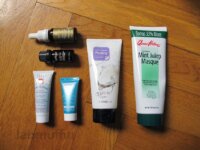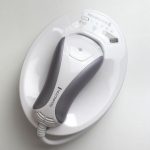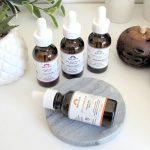Here’s a simple skincare trick that I’ve found ridiculously useful lately that I thought I’d share in case it helps anyone else out. I’m sure I’m not the first person to do it, but I also haven’t seen it discussed anywhere else (though I haven’t been looking very hard).
I’ve started doing something that can be best described as “multi-sunscreening”, a bit like the “multi-masking trend” that a lot of brands are jumping on. I was inspired to do this when I watched Fiddy Snails apply her sunscreen using a BB cushion puff on Instagram, when she patted her sunscreen in all over her face using the puff then went back to part in extra on her pigmentation problem areas.
Here’s my issue: I get pigmentation very quickly on the tops of my cheekbones. It’s an annoying genetic thing that a lot of East Asian people have, and I’ve managed to inherit it from my dad’s side (thaaaanks). Right now it’s not too bad, but mostly because I throw hydroxy acids and vitamin C at it all the time to try to lighten it, and cover it with high UVA protection sunscreen to stop it from getting worse.
The problem is that I also have oily skin, from my mum (again: thaaaanks). The sunscreens with the highest UVA protection that I know of come from French brands Bioderma and La Roche-Posay. And unfortunately, they’re greasy, at least on my oil slick face. Even their “fluids” designed for oily skin turn me into an unsightly mirror ball at the end of the day. So I find myself reaching for more “cosmetically elegant” sunscreens most of the time – usually Bioré Aqua Base Watery Essence – which keep my oily areas manageable but aren’t waterproof or sweatproof, and have lower UVA protection as well. I’ve noticed that my sunspots are steadily creeping back.
Here’s where multi-sunscreening has saved both my long-term skin health as well as my daily try-not-to-look-like-melting-wax efforts. My sunscreen routine now goes like this:
- Apply correct amount of light sunscreen all over face
- Pat on a different, stronger-but-greasier sunscreen on cheekbones and chin
- Let it settle for a few minutes
- Do rest of makeup on top
My oily T-zone doesn’t have to deal with the extra grease, and my problem areas get less photodamage. The high protection sunscreens tend to give more of a white cast, but it’s easily disguised with blush so that’s another problem solved as well.
Does it compromise the protection? I can’t say 100% that it doesn’t, but I’ve taken a few precautions to try to minimise the chances. I cover my entire face with one sunscreen first rather than applying two sunscreens on separate areas and trying not to miss spots. There’s also the possible issue of the two sunscreens having incompatible sunscreening agents and cancelling each other out. Since this usually happens when uncoated inorganic (physical) sunscreen agents zinc oxide and titanium dioxide inactivate other ingredients (e.g. avobenzone and oxybenzone), I haven’t been using any “physical-only” sunscreens with this method (they’re the products most likely to contain uncoated particles). It’s also possible that the two sunscreens have formulas that interfere and make each other clump, but it hasn’t been noticeable so far, and I’m a lot less melty-looking and my spots are fading so I chalk it up as a success!
Here are some of the sunscreens I’ve been using in my multi-sunscreening routine:
“Cosmetically elegant” all-over sunscreen: There’s my beloved Biore Aqua Base Watery Essence SPF 50+ PA++++ of course – it’s light, sinks in quickly, smells pleasantly of citrus and has a slight priming effect.
High-protection sunscreen: My favourite is Bioderma Photoderm MAX SPF 50+ Milk which has a UVAPF of 42. Bioderma sunscreens are unfortunately not available in Australia, so I’ve been using some that I bought in Europe a while back. Bioderma has sunscreens in about 6 different textures, all of which have really high protection. I haven’t seen any sunscreen brands with higher UVAPF values – if you know of any I’d love to hear about them!
Do you have any simple but game changing skincare tips? Let me know in the comments!
Some products were provided for editorial consideration. This post also contains affiliate links – if you decide to click through and support Lab Muffin financially (at no extra cost to you), thank you! For more information, see Disclosure Policy.






Interesting method! And you are spot on about LRP sunscreens – they are greasy like machine oil. I have no idea who LRP are making them for. There are probably less than 5 people in the world with skin dry enough to eat up all that oil and look nice afterwards. Even if the sunscreen ingredients are oil soluble and need some oil to work, it sure must be possible to make a nicer texture using silicones or something. I wonder if LRP just don’t realize how horrible their sunscreens look on skin.
I don’t know anyone with skin that dry either, but I think they must exist somewhere! I have the same issues with silicone as well – I’ve had makeup artists put silicone-based “pore smoothers” on my face and look in horror as it melts off. Generally lower protection (SPF 30) sunscreens have better formulas I think, but I haven’t had the chance to try any SPF 30 LRP ones because I’m instantly seduced by super high protection!
Yes, the LRP sunscreens with orange in their packaging are super greasy BUT they have a fantastic one (with no orange in the packaging) called Uvidea XL. It is 30 spf, very fluid in texture going on (‘extreme fluid’) and has a great finish with none of that grease. I use it every day under makeup.
LRP makes a serum with SPF (i think it’s part of the Anthelios line) that’s awesome to use as a base layer of protection. it’s non-greasy on my super oily skin, and one bottle seems to last forever (i’ve been using the same one for almost a year!)
Interesting! I don’t think I’ve seen it before.
I love your sunscreen posts! That’s a really cool idea/solution!
The sunscreen with the highest UVAPF-value I know is the Uriage Bariésun XP Cream 50+, which has a PPD of 65 (that’s a lot, right?). http://www.uriage.com/AA/en/products/bariesun-xp-creme-spf50-1
I also use the Bioderma sunscreen (I’ve recently switched from the milk to the spray) and it gives me quite a white cast, too, so what I do is I mix in a tiny amount of the Bioderma Photoderm Max tinted cream. I think in some countries they might sell this one in a light shade, too, but unfortunately in France they only seem to sell it in a pretty dark colour (they call it golden, but to me it’s a pretty dark brown). I’ve tried the tinted cream on its own, but that way it’s way too dark for me, mixing a little bit with the spray (or the milk, or the regular cream) however really balances out the white cast. I guess that’s probably too lame and uninspired to really be called a trick, but yeah. I also really like doing this because the Bioderma sunscreens are all quite similar in formula and use mostly the same sunscreen ingredients, so I don’t feel so worried about the different products possibly interfering with one another’s protection.
That’s ridiculously high! Thanks for the rec!
I’m really wary of mixing multiple sunscreens together, or sunscreens with other products, before application – the problem is usually not to do with sunscreen agent compatibility but with formula compatibility and uneven mixing, which means you’re at risk of getting underprotected patches.
No problem! Due to the high PPD I once tried it out, but I have to admit that I didn’t really like the texture, it was greasy, but mostly it just felt really heavy (on my face) to me. I’ve got to say that I’m really sensitive when it comes to products feeling heavy-ish, so maybe other people wouldn’t mind that at all, but yeah, I think I would feel bad to recommend it and then you’d hate the texture.
Oh, now I feel bad about mixing my sunscreens. Hmm, would it perhaps work if I first apply my regular sunscreen (the spray) and then wait for some time (are 15 min enough?) and then put the tinted sunscreen on top?
I used to do it this way with makeup, first apply the sunscreen, let it absorb for a while, then put makeup on top, but when I found the tinted version of the sunscreen, I thought it might be a better solution than makeup.
“here’s also the possible issue of the two sunscreens having incompatible sunscreening agents and cancelling each other out. Since this usually happens with uncoated inorganic (physical) sunscreen agents zinc oxide and titanium dioxide, I haven’t been using any “physical-only” sunscreens with this method”
Umm correct me if I’m wrong, but I thought that they inactivated avobenzone specifically? Not eachother?
in which case, you should avoid all sunscreens with *any* zinc/TD in them, not only all physicals OR you should avoid avobenzone in your protection sunscreen (I think most high-protection euro ss do use avo though)
Sorry – I meant uncoated titanium dioxide or zinc oxide inactivating other ingredients like avobenzone or oxybenzone. Products usually don’t specify whether they contain coated or uncoated, but since the interaction is well known, cosmetic chemists are likely to stick to coated for combo sunscreens. I’ll clarify that now 🙂
Some great tips! I use a separate mineral sunscreen around my eyes and then my Hada Labo UV Creamy Gel everywhere else. I’m curious to try sunscreens by Isdin from Spain but avaliable on ebay, they vary from 40-60 PPD.Not much info on the Internet about them except for their own website.
Have you tried the Body Shop’s Skin Defence Multi-Protection Essence? It’s the first sunscreen I’ve tried that doesn’t make my face feel like an oil spill.
Thank you so much for your blog and for being the voice of (scientific) reason!
Enjoy your blog! Wanted to share a tip my dermatologist gave me, although it’s not a greasy sunscreen issue. When I mentioned that the zinc sunscreens are so white he said to put a little foundation into the sunscreen. I tried it and it does help. You just need a drop of foundation though or its to liquid-y.
Good tip! And it’s definitely a good idea not to add too much – mixing sunscreen with other products causes patchy coverage.
This is a great idea! I do something similar for prolonged/direct exposure. I use a stick sunscreen on my nose and cheeks because they stay on better, on top of my sunscreen. Those areas have been treated for pigmentation and tend to burn easier.
I’ve also been trying using tinted sunscreens as a foundation over my regular sunscreens. It looks odd if I use the full amount of a tinted sunscreen but if I use a dab of them over my regular one sometimes they’ll mattify ( MD Solarsciences tinted spf 30) and even me out a bit as well as add some extra protection. I read this as a tip from Dr. Leslie Baumann somewhere and it seems to work well here in sunny Los Angeles.
This is an awesome idea! I have dry skin and I use lightweight fluid sunscreens so I don’t need to do it, but I’ll let some of my oilier friends in on this – they often skip sunscreen because it makes them so greasy. Is the La Roche-Posay ultra fluid sunscreen available in Australia? I know their sunscreens differ slightly depending on location. I find the ultra fluid a lot more suitable for the face than the regular, thick, creamy ones.
Have you tried the Mecca Cosmetica SPF50? Or their clear spray SPF50?
I’ve only just purchased the latter, so I’m still trialling it but the former is one of the few that won’t slide off my oily skin when I’m out on the golf course. It seems really thick but it rubs in beautifully and doubles as a primer.
lovvee
I’ve been doing this for years out of instinct to protect my freckled, red-headed skin. I thought it was just me! It depends on the weather and how my skin feels, and I sometimes think of it as layering skincare, sort of like layering toners and serums. I live in Seattle where people think I’m crazy to do this, but my derm told me it’s a great idea. He said about 20 years ago that around the time I turned 50 I would see a big difference between my skin and that of my age mates who don’t use sunscreen. I’m 53 now, and it’s true. I don’t look like a teenager, but my skin looks good for my age, particularly the texture and plumpness of the surface. Sometimes the layering happens inadvertently: I apply my first sunscreen in the early morning, and then an hour later I’m in the car and apply more of a different brand. At lunch I’m out and about and whip out a 3rd type from my bag. On the way home I reach for the car tube again. If I’m gardening in the late afternoon I’ll use the tube that is on the shelf next to my gardening gloves. I stash it everywhere. I was not aware of the uncoated particles inactivating chemical screens. Do you have a post on this topic, or can you point me to one? Thanks. I discovered your site over the holidays while reading up on how exactly my Clarisonic works and how much pressure to use. It’s such a pleasure to see the strong science focus.
Thank you so much! I’m hoping I’ll keep up my sunscreen regimen and I’ll also be able to see the results when I’m 50 🙂
I don’t have a post on this topic yet, and there aren’t any obvious studies on them in the context of skincare unfortunately. The safest thing to do is to email the brand and ask if their particles are coated or not.
Hi do you have try on physical sunscreen before? I use for beach holiday few times work well.. but i stop recently from my regular skincare routine as my skin breakout ( i stop all oil things….)
Yep! I quite like it though I don’t use it exclusively. It really depends on which one you get as to how oily it is. Have you tried Biore Aqua Rich Watery Essence? That’s very light and non-oily.
Hi. Is it necessary to apply face moisturizer before sunblock to protect skin from wrinkling effects from strong chemicals contained in sunscreen products? Thank you.
Sunscreens don’t really contain strong wrinkle-causing chemicals, and the studies that have looked at wrinkles and sunscreen have shown that it decreases wrinkling… though perhaps it depends on your definition of strong?
Hello Michelle.
I do my multi-sunscreening the other way. I apply first the greasy one like Bioderma Bioderma Photoderm MAX SPF 50+ Milk and after a few minutes I pat apply the Biore Bright Milk on my forehead, nose, cheekbones and chin. This way I don’t look like a greaseball.
Interesting! I’ll have to give that a go, thanks for the tip 🙂
So I don’t understand — is it safe to apply two different sunscreens if they might cancel each other out? How does one avoid this problem?
I personally love the Clear SPF 30 Fluid from Paula’s Choice for acne-prone skin, it’s extremely light in texture. But because it’s a chemical sunscreen, I was thinking of applying a mineral sunscreen over it on areas that are more prone to future wrinkles…But now I’m not sure if it’s a good idea after reading your wonderful article!
Love,
Olena
what do you think of Paula’s Choice sunscreen? I used it once and it was legit non greasy …even on oily skin.
I’ve only used it once and I remember liking it, but I prefer sunscreens with the newer photostable UVA filters.
My favorite sunscreen is Altruist SPF 50 Face Fluid. Have you tried it? Doesn’t leave my face overly shiny, and the new photostable filters are gentle on my skin.